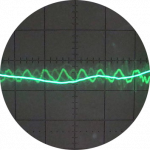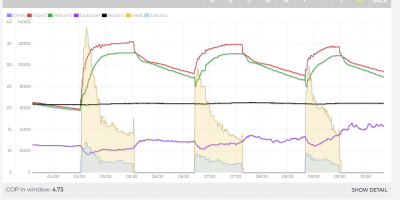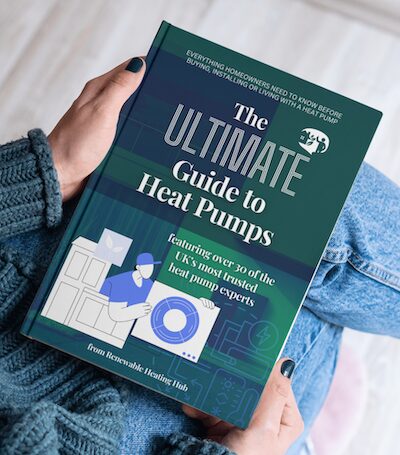@ecobaker please let know if you’re still interested in getting the Installer Reference Guide. I’ll see if I can get it sent to me.
Get a copy of The Ultimate Guide to Heat Pumps
Subscribe and follow our YouTube channel!
Posted by: @ecobakerI am short cycling, the compressor is coming off and on, but I don't know how often in an hour. At what point is too cycles in an hour?
I don’t think there’s a cycling threshold for ASHPs, so there’s probably no definitive answer for how many cycles per hour is "too many".
I don’t have a Hive, but my system runs similarly to yours in some respects. What I don’t understand in your case is why your heat pump is cycling since I assume the room you’ve got the Hive in hasn’t hit 28C, and which I assume it never will, so the heat pump should just be idling at the 29C flow temperature you’ve mentioned.
Get a copy of The Ultimate Guide to Heat Pumps
Subscribe and follow our YouTube channel!
Add a Volumiser, NOT a Buffer Vessel.
@derek-m can you please explain why a volumiser would help in this case?
Get a copy of The Ultimate Guide to Heat Pumps
Subscribe and follow our YouTube channel!
@kenbone any words of wisdom on this Samsung issue?
Get a copy of The Ultimate Guide to Heat Pumps
Subscribe and follow our YouTube channel!
Posted by: @ecobakerSo an update to this issue, I reinstalled the Hive and went back to my old method, had the hive room temp set for 28, but I added water Law compensation. My flow temp has been around 29 all day, and my COP (taken from energy use/genertion on the unit controller, I don't have any monitoring) has been 4.5 today. Although that was without any DWP because I turned it off and forgot about it.
I am short cycling, the compressor is coming off and on, but I don't know how often in an hour. At what point is too cycles in an hour?
I believe it is often stated that cycling at a frequency of 6 or more times per hour is deemed to be short cycling. Obviously the lower the frequency the better.
From the knowledge that I have accumulated due to my involvement with the forum over the past 3 years, the optimum method of reducing cycling frequency is not so straightforward, and may vary from system to system.
I believe that the reason why cycling occurs is now fairly well known, and is simply that the heat pump, even when operating at minimum output, is producing more thermal energy than is required to meet the heating demand. Therefore one way to reduce cycling would be to increase heating demand by asking the control system to increase the Indoor Air Temperature (IAT), which can be done by asking for a higher Leaving Water Temperature (LWT), but this method only works if the warmer water actually gets to the heat emitters, so that thermal energy is being transferred from the heat pump into the home. This method only works if the homeowner is prepared to accept a higher IAT.
I suspect the reason for more frequent cycling may also be related to the location of the LWT and RWT sensors and how the system is being controlled.
Consider what is probably happening in a basic system that is not complicated by having a buffer tank or heat exchanger. If the heat pump is producing slightly more thermal energy than that required by the heating demand, both the LWT and RWT will start to increase, and at some point a high temperature limit will be reached and the heat pump will be stopped. The heat pump will only restart operation when the LWT or RWT falls to a lower limit.
The on and off period of the cycle will therefore be dependent upon how quickly the water heats up and then cools down in the pipework to which the LWT and RWT sensors are attached. I believe on most systems the LWT and RWT sensors are located within the heat pump unit, and may therefore be subjected to cooler OAT.
One possible way to reduce the frequency of cycling would be to make use of a room thermostat as a means of also starting and stopping the heat pump. For this method to work it would probably be necessary to set the low LWT end of the Weather Compensation (WC) curve at a value that runs the heat pump continually at minimum output. With the heat pump kept running at minimum output with the heating demand lower than this value, the IAT will start to rise. This is where the room thermostat comes into play, which should be set at 0.5C or 1C above the normal desired room temperature.
When the IAT reaches the upper setting of the room thermostat the heat pump is stopped, and remains off until the IAT falls to the reset temperature of the room thermostat and the heat pump is restarted.
When correctly adjusted, the cycling frequency of the heat pump should be dictated by the room thermostat and not by the LWT and RWT sensors.
Posted by: @ecobaker@editor Thanks, sounds like you know all the right people to speak to.
😂 I know a lot the right people to contact, yes, but I’m not sure that the info is always right.
You don’t have a buffer installed, correct?
Get a copy of The Ultimate Guide to Heat Pumps
Subscribe and follow our YouTube channel!
Posted by: @editorAdd a Volumiser, NOT a Buffer Vessel.
@derek-m can you please explain why a volumiser would help in this case?
A buffer tank has the potential of just making matters worse, while a volumiser would not make matters worse and may even make a slight improvement.
Read the post I have just sent for a better understanding.
@editor Yeah if you can get the refference guide that would be great. One of the main issues I have with a samsung system, is the absolutly awful documentation. Its very technical and not clear at all, given that these units are to be fitted in domestic properties, the style of documentation is really poor. So anything else I can get my hands on would be good.
So when I adjusted the WC so the flow temp stayed above 31c it doesn't short cycle, it just stays on all the time. I think from what others have said, when it was lower than 31c, due to the volume in my system, the output of the pump would be lower than the minimum allowed, thus it cycles on and off.
No I don't have a buffer tank, but there is a low loss header installed.
Samsung Gen6 8kw ASHP in a two bed victorian mid terrace.
Posted by: @ecobaker@editor Yeah if you can get the refference guide that would be great. One of the main issues I have with a samsung system, is the absolutly awful documentation. Its very technical and not clear at all, given that these units are to be fitted in domestic properties, the style of documentation is really poor. So anything else I can get my hands on would be good.
So when I adjusted the WC so the flow temp stayed above 31c it doesn't short cycle, it just stays on all the time. I think from what others have said, when it was lower than 31c, due to the volume in my system, the output of the pump would be lower than the minimum allowed, thus it cycles on and off.
The required volume of water in the system is more to do with the defrost cycle, and has little effect on mild weather cycling. Please read the post I sent previously.
The required volume of water in the system is more to do with the defrost cycle, and has little effect on mild weather cycling. Please read the post I sent previously.
@derek-m Oh doesn't the volume of water circulating into the rads determine how much energy is being out putted from the heat pump? A system with more volume of water requires more energy and thus the heatpump will meet is minimum power requirements. Or have I got that wrong?
Samsung Gen6 8kw ASHP in a two bed victorian mid terrace.
Posted by: @ecobakerThe required volume of water in the system is more to do with the defrost cycle, and has little effect on mild weather cycling. Please read the post I sent previously.
@derek-m Oh doesn't the volume of water circulating into the rads determine how much energy is being out putted from the heat pump? A system with more volume of water requires more energy and thus the heatpump will meet is minimum power requirements. Or have I got that wrong?
I think you are quite correct as long as the extra volume is in your radiators. The more emitters that you have, the more heat will be emitted, which will help keep the power required from the heat pump above the minimum.
@ecobaker so... your points, summarised.
the guides you need are all here. type MIM-E03CN into the search.
the MIM controller manual has all the parameters. everything else you need to learn from youtube and reading .
don't even think about using water outlet mode. I've discussed this with few people on this and the OEM forum. It just comes on and off with heinous short cycles, trying to keep the WT within a very narrow band. ignoring all other data and inputs.
to run at a constant(ish) WT, you need run in water law mode, set the WC to whatever, and then switch the unit on /off either with an external stat, or preferably using the controller itself as the room stat. the latter gets the best performance.
But the lower the flow temp, the lower the radiator output. If this is less than the minimum output of the HP, it will (almost certainly short) cycle. A typical strategy for this , is to set the low point of the WC a little bit higher so the rad output balances the system minimum. then the system stays stable running. the house will warm up, because the output is more than the house needs. then it will switch off on the stat, and cool again, until the stat calls for heat again. which gets you long cycles. clear example of this on my Gen6 system from today:
obviously you can go bigger rads to move the point at which this happens lower (to a warmer OAT), but at some point you just accept the diminishing returns (or don't need heating).
the 40% number thats been mentioned, it depends on which G6 unit you have. I can get my 16kw down to about 23% (see graph). the 12kw is worse as a percentage because its floor is the same as the 16 (its the same hardware)
My octopus signup link https://share.octopus.energy/ebony-deer-230
210m2 house, Samsung 16kw Gen6 ASHP Self installed: Single circulation loop , PWM modulating pump.
My public ASHP stats: https://heatpumpmonitor.org/system/view?id=45
11.9kWp of PV
41kWh of Battery storage (3x Powerwall 2)
2x BEVs
- 26 Forums
- 2,364 Topics
- 53.6 K Posts
- 394 Online
- 6,029 Members
Join Us!
Worth Watching
Latest Posts
-
-
RE: Octopus Cosy Heat Pump Owners & Discussion Thread
@kevh it's worth remembering that many lsvs only actual...
By JamesPa , 11 hours ago
-

@majordennisbloodnok Education, Education, Education…
By Toodles , 14 hours ago
-

RE: Setback savings - fact or fiction?
Exactly. We only need to compare conditions, to decide ...
By cathodeRay , 18 hours ago
-
RE: Balancing financial efficiency and comfort using the Octopus Cosy tariff
I found because I have very low heat loss I can set bac...
By RadWhisperer , 21 hours ago
-
RE: Need Help Optimising My Rushed ECO4 Install: 12kW Bosch Heat Pump
Welcome @mickamills We too have an oversized 12kW Sa...
By Old_Scientist , 1 day ago
-
RE: My Powerwall 3 Consumes 3-4 kWh/Day in Self-Consumption: Is This Normal?
@caron I can confirm that the power usage of the PW3 is...
By Old_Scientist , 1 day ago
-
RE: Speedcomfort radiator fans
Thats true, but having tried (and succeeded) in constru...
By JamesPa , 1 day ago
-
RE: Solis S6-EH1P8K-L-PLUS – Why I Chose It and What I’ve Learned So Far
@bash brilliant, thanks for the feedback
By energy9165 , 1 day ago
-

RE: Heat Pump Heats the House… But It’s Not Cosy. Emitter Changes or System Tweak?
@alastair There I was, feeling grumpy, he said “Cheer u...
By Toodles , 1 day ago
-
RE: Grant Aerona: Is there a setting to keep the 2-port valve open during pump blockade
Depends on OAT. Mine cycles at OAT>10 and of course...
By JamesPa , 1 day ago
-
RE: New Fogstar 15.5kWh upright solution
@transparent My conclusion is as you have noted, tha...
By Bash , 2 days ago
-
RE: Mitsubishi Ecodan R290 10kW performance
And to you too. Wishing you a very enjoyable festive s...
By Sheriff Fatman , 2 days ago
-

RE: External pipework insulation
They do? But that isn't apparent from the photos we'r...
By Transparent , 2 days ago
-

RE: Say hello and introduce yourself
@velcro welcome to the forums. Please feel free start a...
By Mars , 2 days ago
-
Daikin EDLA11D3V3 DHW Settings
I have a newly installed EDLA11D3V3 which I'm still get...
By Velcro , 2 days ago
-
RE: Midea ASHP – how to set weather compensation
@curlykatie did you get sorted with this?
By MickaMills , 2 days ago
-
RE: MyVaillant Connect Regular Disconnect
Thanks. Yes, if the time is consistently 11pm every nig...
By buckwem , 3 days ago






